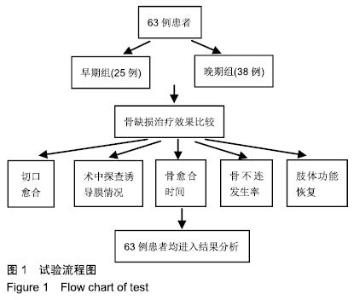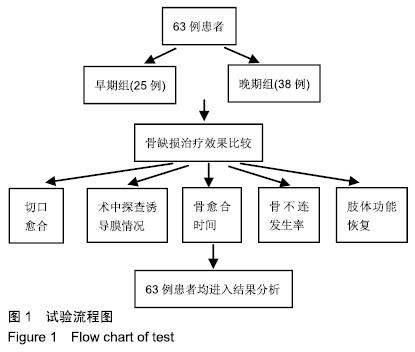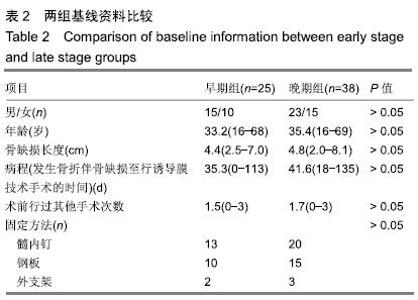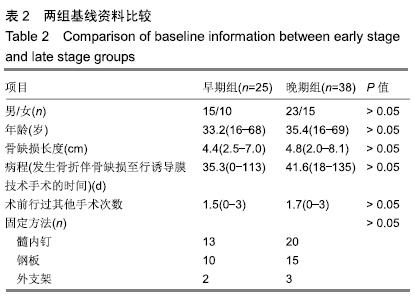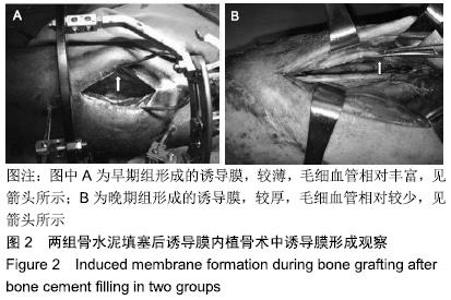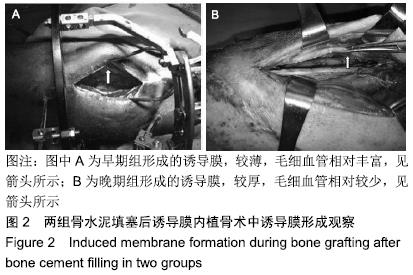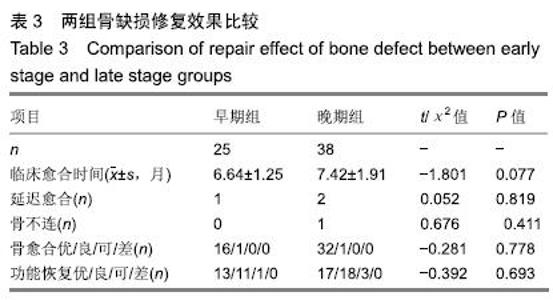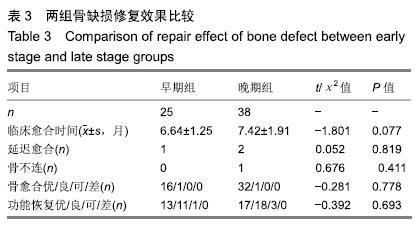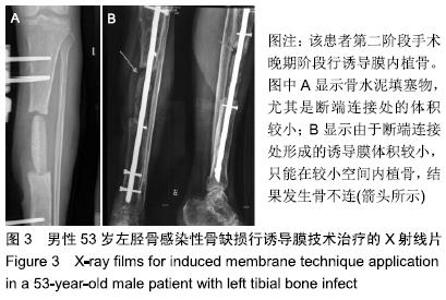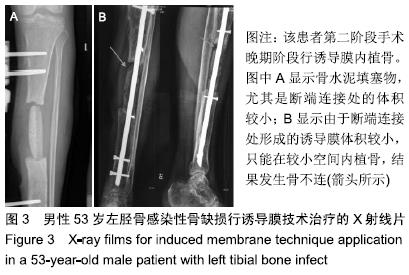[1] 周子红,冯德宏,徐可林,等.诱导膜技术的手术失误和并发症:44例感染性骨缺损治疗分析[J].中国组织工程研究, 2018,22(26): 4162-4167.
[2] MORELLI I, DRAGO L, GEORGE D, et al.Masquelet technique: Myth or reality?A systematic review and meta-analysis. Injury. 2016; 47:68-76.
[3] 黄进成,刘曦明,蔡贤华,等.Masquelet技术治疗感染性骨缺损的研究进展[J].中国矫形外科杂志,2017,25(20):1867-1871.
[4] 陈宇杰,周耀东,刘德荣,等.Masquelet技术治疗创伤后骨缺损[J].中华创伤骨科杂志,2013,15(6):540-542.
[5] 殷渠东,顾三军,芮永军,等.诱导膜技术治疗骨缺损的疗效分析[J].中华骨科杂志, 2016,36(20):1284-1293.
[6] PELISSIER P, MASQUELET AC, BAREILLE R, et al.Induced membranes secrete growth factors including vascular and osteoinductive factors and could stimulate bone regeneration. J Orthop Res.2004;22(1):73-79.
[7] ZWETYENGA N, CATROS S, EMPARANZA A, et al. Mandibular reconstruction using induced membranes with autologous cancellous bone graft and HA-betaTCP: animal model study and preliminary results in patients.Int J Oral Maxillofac Surg. 2009;38(12):1289-1297.
[8] WONG TM, LAU TW, LI X, et al.Masquelet technique for treatment of posttraumatic bone defects. ScientificWorldJournal.2014;2014:710302.
[9] CHRISTOU C, OLIVER RA, YU Y, et al.The Masquelet technique for membrane induction and the healing of ovine critical sized segmental defects.PLoS One. 2014;9(12): e114122.
[10] PALEY D, HERZENBERG JE, PAREMAIN G, et al.Femoral lengthening over an intramedullary nail.A matched-case comparison with Ilizarov femoral lengthening.J Bone Joint Surg Am.1997;79(10):1464-1480.
[11] KLAUE K, KNOTHE U, ANTON C, et al.Bone regeneration in long-bone defects: tissue compartmentalisation? In vivo study on bone defects in sheep.Injury.2009;40(Suppl 4):S95-102.
[12] DONEGAN DJ, SCOLARO J, MATUSZEWSKI PE, et al. Staged bone grafting following placement of an antibiotic spacer block for the management of segmental long bone defects. Orthopedics. 2011;34(11):e730-735.
[13] 雷鸣,王敏,张催.万古霉素骨水泥对骨折内固定术后髓内感染的疗效观察[J].抗感染药学,2014,11(5):538-540.
[14] MORELLI I, DRAGO L, GEORGE DA, et al.Masquelet technique: myth or reality? A systematic review and meta-analysis. Injury. 2016;47(Suppl 6):S68-S76.
[15] WANG X, WANG Z, FU J, et al.Induced membrane technique for the treatment of chronic hematogenous tibia osteomyelitis. BMC Musculoskelet Disord.2017;18(1):33.
[16] LUO F, WANG X, WANG S, et al.Induced membrane technique combined with two-stage internal fixation for the treatment of tibial osteomyelitis defects.Injury.2017;48(7):1623-1627.
[17] 汪小华,傅景曙,沈杰,等.诱导膜技术治疗胫骨创伤后骨髓炎[J].中华创伤杂志,2015,31(4):299-302.
[18] 李林,林达生,郝健明,等.Masquelet技术治疗胫骨大段骨缺损的疗效分析[J].中华创伤骨科杂志,2014,16(1):88-90.
[19] KONDA SR, GAGE M, FISHER N, et al.Segmental bone defect treated with the induced membrane technique.J Orthop Trauma.2017;31(Suppl 3):S21-S22.
[20] WONG TM, LAU TW, LI X, et al.Masquelet technique for treatment of posttraumatic bone defects. ScientificWorldJournal.2014;2014:710302.
[21] VIATEAU V, GUILLEMIN G, CALANDO Y, et al.Induction of a barrier membrane to facilitate reconstruction of massive segmental diaphyseal bone defects:an ovine model.Vet Surg. 2006; 35(5):445-452.
[22] ZWETYENGA N, CATROS S, EMPARANZA A, et al. Mandibular reconstruction using induced membranes with autologous cancellous bone graft and HA-betaTCP:animal model study and preliminary results in patients.Int J Oral Maxillofac Surg. 2009;38(12):1289-1297.
[23] 李宗原,唐诗添,王军,等.Masquelet技术联合组织瓣移植修复骨软组织复合缺损[J].中国修复重建外科杂志, 2016,30(8): 966-970.
[24] 沈友银,杨月舟,汤龙海,等.利用钛网包裹打压松质骨植骨治疗上肢长骨较长骨缺损[J].中华手外科杂志,2016,32(4):279-230.
[25] 殷渠东,顾三军,芮永军,等.松质骨包裹植骨技术治疗长骨节段性骨缺损:50例报告和文献复习[J].中华创伤骨科杂志, 2017,19(9): 775-781.
[26] APARD T, BIGORRE N, CRONIER P, et al.The mechanism of action of induced membranes in bone repair.J Bone Joint Surg Am. 2013;95(7):597-604.
[27] HENRICH D, SEEBACH C, NAU C, et al.Establishment and characterization of the Masquelet induced membrane technique in a rat femur critical-sized defect model.J Tissue Eng Regen Med.2016;10(10):E382-E396.
|
